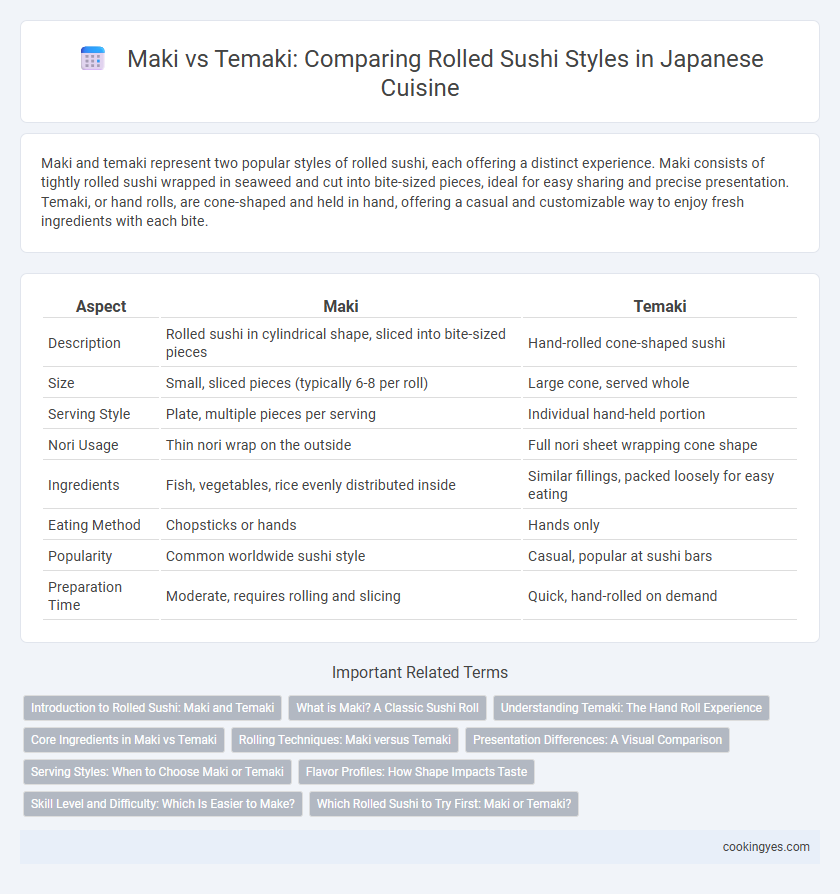Maki and temaki represent two popular styles of rolled sushi, each offering a distinct experience. Maki consists of tightly rolled sushi wrapped in seaweed and cut into bite-sized pieces, ideal for easy sharing and precise presentation. Temaki, or hand rolls, are cone-shaped and held in hand, offering a casual and customizable way to enjoy fresh ingredients with each bite.
Table of Comparison
| Aspect | Maki | Temaki |
|---|---|---|
| Description | Rolled sushi in cylindrical shape, sliced into bite-sized pieces | Hand-rolled cone-shaped sushi |
| Size | Small, sliced pieces (typically 6-8 per roll) | Large cone, served whole |
| Serving Style | Plate, multiple pieces per serving | Individual hand-held portion |
| Nori Usage | Thin nori wrap on the outside | Full nori sheet wrapping cone shape |
| Ingredients | Fish, vegetables, rice evenly distributed inside | Similar fillings, packed loosely for easy eating |
| Eating Method | Chopsticks or hands | Hands only |
| Popularity | Common worldwide sushi style | Casual, popular at sushi bars |
| Preparation Time | Moderate, requires rolling and slicing | Quick, hand-rolled on demand |
Introduction to Rolled Sushi: Maki and Temaki
Maki and Temaki represent two popular styles of rolled sushi distinguished by shape and eating experience. Maki features tightly rolled sushi rice and fillings wrapped in seaweed, sliced into bite-sized pieces, making it convenient for sharing and presentation. Temaki, or hand rolls, are cone-shaped with more loosely packed ingredients, offering a casual, handheld sushi experience that highlights freshness and texture variety.
What is Maki? A Classic Sushi Roll
Maki is a classic sushi roll consisting of vinegared rice and fillings such as fish, vegetables, or seafood, all tightly wrapped in a sheet of nori (seaweed). This traditional roll is typically cut into bite-sized pieces, making it easy to eat and popular worldwide. The precision in rolling and the balance of flavors make Maki a fundamental staple in Japanese cuisine.
Understanding Temaki: The Hand Roll Experience
Temaki, also known as hand rolls, are cone-shaped sushi pieces wrapped in nori seaweed and filled with sushi rice, fresh fish, and vegetables, offering a convenient and portable dining experience. Unlike Maki rolls that are sliced into bite-sized pieces, Temaki allows for a customizable and interactive eating style where diners enjoy individual rolls hand-crafted with a variety of textures and flavors. The large, open-ended roll emphasizes freshness and presentation, making Temaki a popular choice for sushi enthusiasts seeking a casual yet authentic taste.
Core Ingredients in Maki vs Temaki
Maki sushi features core ingredients such as vinegared rice, fresh fish or vegetables, and nori seaweed, tightly rolled into a cylindrical shape using a bamboo mat. Temaki sushi, on the other hand, consists of similar core ingredients but is hand-rolled into a cone shape, allowing for a more casual presentation and customizable fillings. Both styles emphasize fresh, high-quality fish, crisp vegetables, and seasoned rice, but Maki prioritizes uniformity, while Temaki focuses on portability and ease of eating.
Rolling Techniques: Maki versus Temaki
Maki sushi showcases a precise rolling technique where rice and fillings are evenly spread on nori and tightly rolled using a bamboo mat, resulting in uniform cylindrical slices. Temaki, or hand rolls, use a looser rolling method where ingredients are placed on a nori sheet and rolled by hand into a cone shape, allowing for a more customizable and textured eating experience. The controlled compression in maki preserves the sushi's structure and bite, while temaki emphasizes freshness and ease of assembly.
Presentation Differences: A Visual Comparison
Maki sushi features neatly rolled, cylindrical slices wrapped in seaweed, offering a uniform and compact appearance perfect for elegant plating. Temaki sushi, shaped as cone-shaped hand rolls, boasts a casual, open-ended presentation that showcases colorful fillings and is ideal for individual serving. The distinct visual contrast lies in Maki's precise, bite-sized pieces versus Temaki's artisanal, handheld style, both emphasizing freshness and texture through different forms.
Serving Styles: When to Choose Maki or Temaki
Maki sushi, neatly rolled and sliced into bite-sized pieces, is ideal for formal dining or sharing in groups, offering a balanced presentation and ease of eating with chopsticks. Temaki, or hand rolls, are cone-shaped and served individually, perfect for casual settings or when a personalized, interactive dining experience is desired. Choose maki for organized platters and temaki for a fun, customizable approach to sushi consumption.
Flavor Profiles: How Shape Impacts Taste
Maki sushi, with its compact cylindrical shape, offers a balanced bite where flavors from the filling, rice, and nori are evenly distributed, enhancing the harmony of tastes in each piece. Temaki, shaped like a cone, provides a more dynamic flavor experience as the ingredients are less tightly packed, allowing the texture and freshness of fillings to stand out with each varied bite. The shape of maki ensures consistent flavor delivery, while temaki's open form emphasizes intense, individual ingredient flavors, influencing overall taste perception significantly.
Skill Level and Difficulty: Which Is Easier to Make?
Maki sushi involves rolling rice and fillings tightly in seaweed using a bamboo mat, requiring moderate skill to achieve uniform rolls and precise slicing. Temaki, or hand rolls, are cone-shaped and formed by hand, making them easier for beginners due to less precision needed and no specialized tools required. Overall, Temaki sushi is simpler to make and more forgiving of inconsistencies compared to the structured technique needed for Maki.
Which Rolled Sushi to Try First: Maki or Temaki?
Maki sushi features tightly rolled rice, seaweed, and fillings sliced into bite-sized pieces, making it ideal for sushi beginners seeking a balanced taste and easy-to-handle texture. Temaki, or hand rolls, consist of cone-shaped seaweed filled with rice and ingredients, offering a more casual experience with customizable fillings and a crunchier seaweed texture. Choosing Maki first introduces classic flavors and portion control, while Temaki provides a fun, hands-on approach to exploring diverse sushi combinations.
Maki vs Temaki for rolled sushi styles Infographic

 cookingyes.com
cookingyes.com